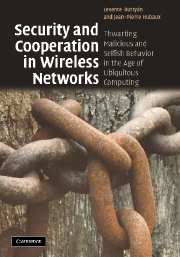 Security and Cooperation in Wireless Networks
Security and Cooperation in Wireless Networks Book contents
- Frontmatter
- Contents
- Preface
- Acknowledgements
- Part I Introduction
- Part II Thwarting malicious behavior
- Part III Thwarting selfish behavior
- 9 Selfish behavior at the MAC layer of CSMA/CA
- 10 Selfishness in packet forwarding
- 11 Wireless operators in a shared spectrum
- 12 Secure protocols for behavior enforcement
- Appendix A Introduction to cryptographic algorithms and protocols
- Appendix B A tutorial on game theory for wireless networks
- References
- Index
9 - Selfish behavior at the MAC layer of CSMA/CA
from Part III - Thwarting selfish behavior
Published online by Cambridge University Press: 05 June 2012
- Frontmatter
- Contents
- Preface
- Acknowledgements
- Part I Introduction
- Part II Thwarting malicious behavior
- Part III Thwarting selfish behavior
- 9 Selfish behavior at the MAC layer of CSMA/CA
- 10 Selfishness in packet forwarding
- 11 Wireless operators in a shared spectrum
- 12 Secure protocols for behavior enforcement
- Appendix A Introduction to cryptographic algorithms and protocols
- Appendix B A tutorial on game theory for wireless networks
- References
- Index
Summary
For our first analysis of selfish (or greedy) behavior in wireless networks, we will focus on the MAC layer. More specifically, we will focus on IEEE 802.11, (the security of which we have already discussed in Chapter 1) because (i) this protocol is by far the most popular in existing wireless LANs, (ii) the devices (access points and wireless adapters) are very inexpensive, (iii) simulation code is widely available, and (iv) consequently the interested reader can relatively easily experiment the ideas developed in this chapter. In other words, the prominence of this protocol in wireless networks is such that it is the optimal candidate to illustrate the concepts of Part III of this book with a concrete example. The subsequent chapters will be (as all of the ones of Part II) standard-independent, with the exception of Section 11.2 in which we will refer to UMTS.
In IEEE 802.11, the stations (including the access point) in a given radio domain can transmit only one at a time. The temptation for selfish behavior is obvious, as the radio link is shared between all stations in power range: by departing from the protocol, a cheating station can substantially increase its bandwidth, at the expense of the other stations.
In the first section of this chapter, we briefly describe the operating principles of IEEE 802.11, which need to be known for a proper understanding of this chapter.
- Type
- Chapter
- Information
- Security and Cooperation in Wireless NetworksThwarting Malicious and Selfish Behavior in the Age of Ubiquitous Computing, pp. 275 - 330Publisher: Cambridge University PressPrint publication year: 2007


